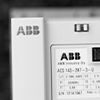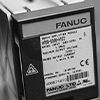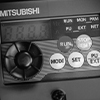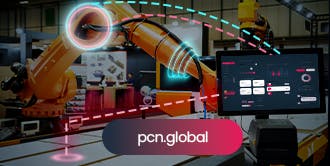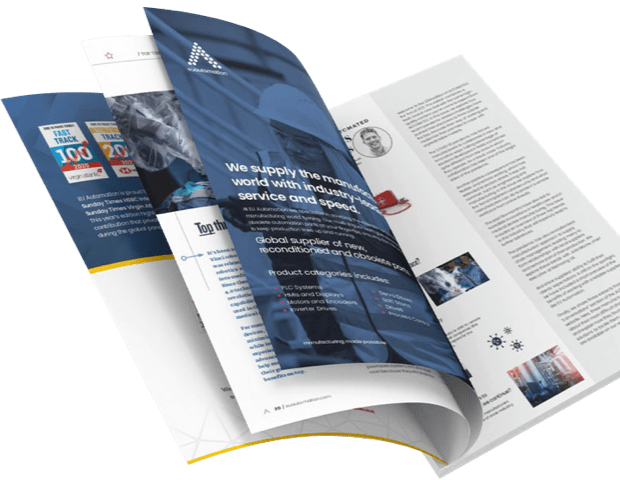Track lifecycle updates for your critical components
May 1, 2025
You can’t replace what you don’t track. Effective lifecycle management is key to keeping operations running smoothly and reducing business costs. End-of-life products and obsolete components have the ability to cause major disruptions if they are not managed in a proactive manner.
EU Automation’s product lifecycle calendar provides practical insights, helping businesses track critical components from major industry manufacturers. By keeping up with lifecycle updates, you can lessen risks, streamline procurement, and keep production running effectively.
Why does lifecycle management matter?
By using lifecycle management, procurement and maintenance teams can see exactly what lifecycle stages automation equipment is going through at any given time. Regular manufacturer updates on active, phase-out and obsolete components help teams anticipate changes.
Being aware of the situation early on helps with strategic inventory management, timely upgrades, and avoiding costly emergency sourcing of hard-to-find parts. Maintenance of stable operational performance and prevention of downtime are both achieved through proactive management of these transitions.
Explore lifecycle updates by manufacturer
EU Automation supplies parts from major global automation brands, making your procurement simpler. We have given priority to manufacturers whose lifecycle transitions will have the greatest influence due to their large-scale presence in the industry. This overview provides quick access to important lifecycle details for these manufacturers:
This guide offers straightforward access to lifecycle data. It also provides sourcing solutions for those planning upgrades, managing legacy equipment, or seeking obsolete components. With EU Automation’s global network, you can manage obsolescence risks effectively and ensure continuous operations.
Understanding OEM lifecycle models
Manufacturers use varying terms and timelines for product lifecycle management, which can cause confusion. Common lifecycle stages include Active, Classic, Limited, Discontinued and Obsolete. Replacement planning, technical support, and the availability of spare parts are all impacted differently at each level. While some manufacturers provide limited "last-time-buy" periods, others provide longer support once a product is discontinued.

EU Automation has compiled a clear glossary of lifecycle terms to simplify manufacturer terminology. With the help of this glossary, you will have a better understanding of each stage, which will make it easier for you to handle lifecycle transitions.
Critical components lifecycle calendar
Siemens: Lifecycle management for PLCs, HMIs and gateways
Siemens equipment, widely used in global manufacturing, includes products like the S7-300 and ET 200M approaching critical lifecycle stages. Siemens regularly issues detailed end-of-life product notices and phase-out timelines. Keeping track of Siemens' component lifecycle statuses allows proactive procurement and reduces downtime and supply chain risks. Included below is a chart that provides an overview of the lifetime data for the Siemens part families that are most in demand by our customers.

*Dates and phases are drawn from current OEM bulletins and trusted sources but may change without notice. Use them as guidance only when researching and sourcing components.
- SIMOTION D445-2/D455-2
- SIMATIC HMI KTP400F Mobile
- SIMATIC HMI Comfort Panels 15-22 inch
- SINAMICS Connect 300 IoT Gateway
- SIMATIC S7-300 & ET 200M
- S7-1500 (1511, 1513, 1515 and 1516) CPUs
- ET 200SP (1510SP and 1512SP) CPUs
View Siemens product availability on EU Automation
ABB: Lifecycle stages for industrial drives
ABB’s industrial drives, including ACS800 and ACS355, are critical components for motor control applications worldwide. ABB clearly defines lifecycle stages: Active, Classic, Limited, and Obsolete, each with specific support and availability conditions. Keeping informed of ABB's lifecycle statuses allows for better management of older equipment and avoidance of unexpected sourcing issues. The ABB part families that our customers seek the most often have their lifecycle insights highlighted below.

*Dates and phases are drawn from current OEM bulletins and trusted sources but may change without notice. Use them as guidance only when researching and sourcing components.
- Product type ACS800 (based on ACS600 multidrive hardware)
- ACS355 Drives
Explore ABB drive availability on EU Automation
Lenze: Lifecycle guidance for servo and vector drives
Lenze inverter drives, including the 8200 Vector, 9300 Servo and 9400 HighLine series, are common in industrial automation. Today, many of these drives are considered pieces of legacy equipment, and they are moving into later lifecycle stages. Lenze’s clear lifecycle model (Active, Classic, Limited and Discontinued) details service and parts availability.
Managing Lenze’s lifecycle transitions carefully avoids unplanned downtime and emergency sourcing issues. Below, you'll find a chart highlighting lifecycle data for the Lenze part families most in demand by our customers.

*Dates and phases are drawn from current OEM bulletins and trusted sources but may change without notice. Use them as guidance only when researching and sourcing components.
- 8200 Vector Drives
- ECS Servo Drives
- 9300 Servo Drives
- 9300 Vector Drives
- 8200 Motec Drives
Explore available Lenze parts on EU Automation
Mitsubishi Electric: Lifecycle stages for MELSEC PLCs
Many automation systems rely on the MELSEC-Q/L, FX3GE, and Alpha & L Series PLCs from Mitsubishi Electric. These products are currently transitioning through Active, Production Discontinued, Maintenance and Obsolete phases. Understanding Mitsubishi’s lifecycle stages allows for proactive sourcing, reducing operational risks significantly. Below, you'll find a chart highlighting lifecycle data for the Mitsubishi Electric part families most in demand by our customers.

*Dates and phases are drawn from current OEM bulletins and trusted sources but may change without notice. Use them as guidance only when researching and sourcing components.
- Alpha & L Series PLC power supplies
- MELSEC-Q/L & NZ2 Modules (various)
- MELSEC FX3GE PLC
- MELSEC-Q Series C Controller Modules
View Mitsubishi Electric availability on EU Automation
Omron: Lifecycle management for CJ Series PLCs and I/O modules
Omron’s CJ1W modules, widely used in automated production, are now undergoing key lifecycle transitions. Omron clearly identifies lifecycle phases: Active, Discontinuation, Discontinued and Obsolete. Timely updates on Omron’s lifecycle status allow for effective planning, proactive sourcing and ongoing operational performance. Below, we’ve highlighted lifecycle insights for the Omron part families most frequently requested by our customers.
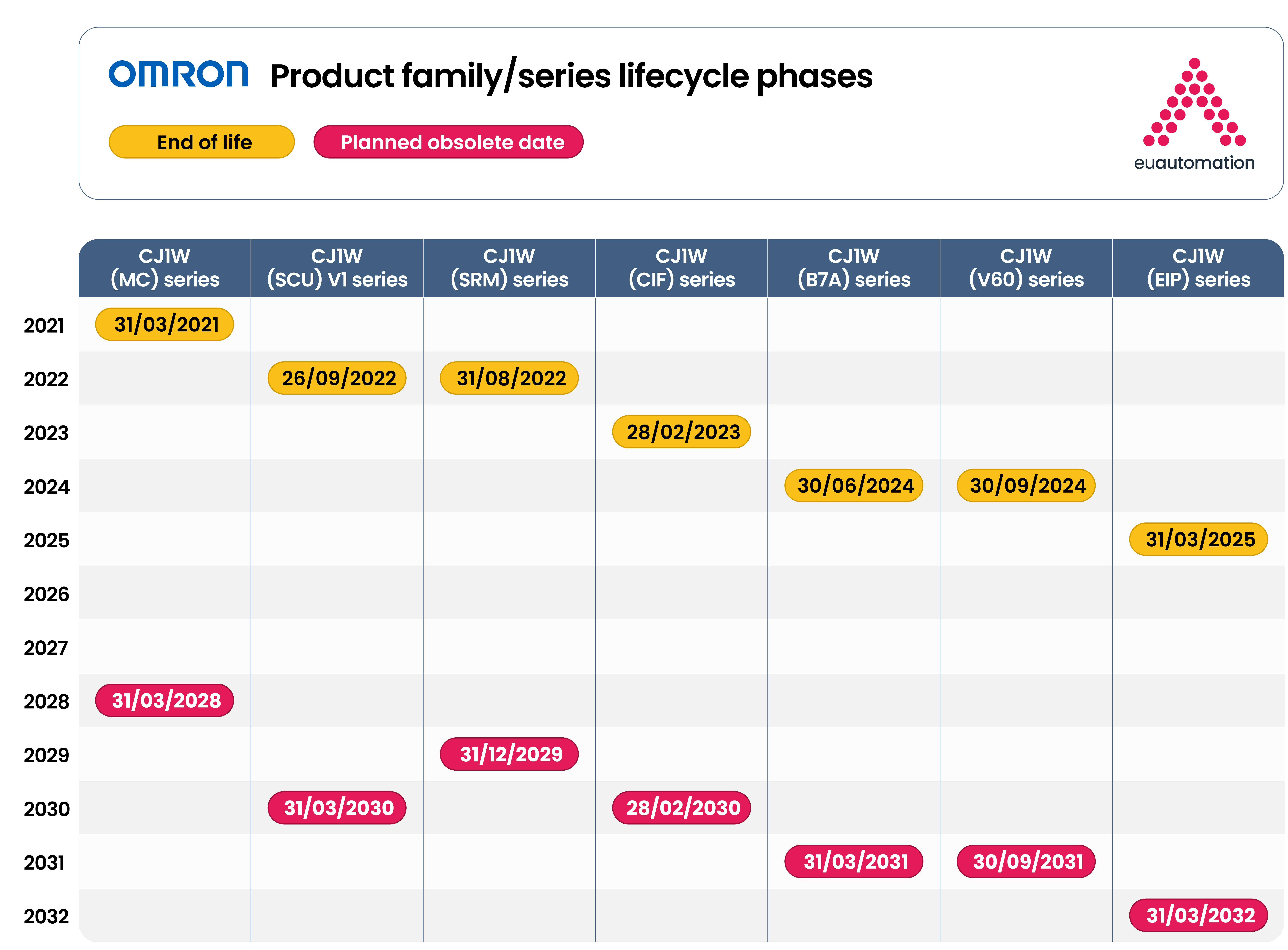
*Dates and phases are drawn from current OEM bulletins and trusted sources but may change without notice. Use them as guidance only when researching and sourcing components.
- CJ1W (B7A) series
- CJ1W (CIF) series
- CJ1W (EIP) series
- CJ1W (MC) series
- CJ1W (SCU) V1 series
- CJ1W (SRM) series
- CJ1W (V60) series
View Omron availability on EU Automation
Bridging obsolescence gaps with EU Automation
EU Automation helps you bridge the gap between obsolescence and ongoing production. Even after OEM support expires, we can reliably supply legacy equipment and obsolete components through our vast global network. We can assist you in sourcing discontinued PLCs, servo drives, and any other hard-to-find automation parts. Our goal is to help keep your operations running smoothly without any interruptions.
Take control of lifecycle risks with lifecycle management
Effective lifecycle management supports proactive operational planning. EU Automation helps bridge the gap between OEM lifecycle notices and action, supporting your efforts to source critical components and maintain uptime.
Bookmark this page, share it with colleagues, and check back often for updates. With EU Automation, you can manage lifecycle transitions confidently, optimise procurement processes, and minimise production downtime.
Table of sources
- https://support.industry.siemens.com/cs/document/109975565/product-cancellation-of-simotion-d445-2-d455-2-devices?dti=0&lc=en-GB
- http://support.industry.siemens.com/cs/document/109823231/announcement-of-the-product-phase-out-(p-m-400)-of-the-simatic-hmi-ktp400f-mobile-on-october-01-2024?dti=0&lc=en-NL
- https://support.industry.siemens.com/cs/document/109824856/announcement-of-the-product-phase-out-of-simatic-hmi-comfort-panels-15-22-as-of-october-1-2024?dti=0&lc=en-DK
- https://support.industry.siemens.com/cs/document/109824450/product-discontinuation-of-the-sinamics-connect-300-iot-gateway?dti=0&lc=en-AZ
- https://support.industry.siemens.com/cs/document/109809890/information-about-the-product-phase-out-of-s7-300-et-200m-components?dti=1&lc=en-GB
- https://support.industry.siemens.com/cs/document/109824856/announcement-of-the-product-phase-out-of-simatic-hmi-comfort-panels-15-22-as-of-october-1-2024?dti=0&lc=en-DK#:~:text=The%20SIMATIC%20HMI%20Comfort%20Panels%2015%22%20%2D%2022%22%20will%20no,will%20begin%20(P.M%20400).
- https://support.industry.siemens.com/cs/document/109963175/declaration-of-phase-out-for-s7-1500-1511-(t-tf)-1513-1515-(f-t-tf)-1516-(f)-cpus-and-et-200sp-1510sp-(f)-1512sp-(f)-cpus?dti=0&lc=en-US
- https://support.industry.siemens.com/cs/document/109767411/update-announcement-of-product-phase-out-for-et-200s-components-(status-february-2025)?dti=1&lc=en-PA
- https://search.abb.com/library/Download.aspx?DocumentID=4FPS10000657232&LanguageCode=en&DocumentPartId=&Action=Launch&DocumentRevisionId=C
- https://search.abb.com/library/Download.aspx?DocumentID=4FPS10002127509&utm_source=chatgpt.com
- https://www.lenze.com/support/13436168?c=eyJhcHBLZXkiOiI5OG5qdjJscnp0IiwiY29uZmlnS2V5IjoidG1sNXJ0M24wNiJ9
- https://www.lenze.com/support/13230898?c=eyJhcHBLZXkiOiI5OG5qdjJscnp0IiwiY29uZmlnS2V5IjoidG1sNXJ0M24wNiJ9
- https://www.lenze.com/support/00484755?c=eyJhcHBLZXkiOiI5OG5qdjJscnp0IiwiY29uZmlnS2V5IjoidG1sNXJ0M24wNiJ9
- https://www.lenze.com/support/00404984?c=eyJhcHBLZXkiOiI5OG5qdjJscnp0IiwiY29uZmlnS2V5IjoidG1sNXJ0M24wNiJ9
- https://www.lenze.com/support/00415164?c=eyJhcHBLZXkiOiI5OG5qdjJscnp0IiwiY29uZmlnS2V5IjoidG1sNXJ0M24wNiJ9
- https://www.apc.com/us/en/faqs/FA169693
- https://eu-assets.contentstack.com/v3/assets/blt5412ff9af9aef77f/blt22541b274839d8f9/EOL-PLC-240408-1961_NZ2_Q_L_WS_Modules_Reveision_A_EN.pdf
- https://eu-assets.contentstack.com/v3/assets/blt5412ff9af9aef77f/blt14dbf635ac61debe/EOL-PLC-240426-1971_FX3G_GE_Revesion%20B_ENG.pdf?utm_source=chatgpt.com
- https://www.mitsubishielectric.com/fa/document/technews_discon/plc/fa-a-0446/faa0446a.pdf
- https://www.meyn.com/news/end-of-life-announcements/
- https://files.omron.eu/downloads/latest/discontinuation_notice/en/cj-series_various_models_(europe_only)_discontinuation_notice_en.pdf?v=1
- https://files.omron.eu/downloads/latest/discontinuation_notice/en/2022725_b7a-series_discontinuation_notice_en.pdf?v=1
- https://files.omron.eu/downloads/latest/discontinuation_notice/en/cj1w-cif21_discontinuation_notice_en.pdf?v=1
- https://files.omron.eu/downloads/latest/discontinuation_notice/en/cj-series_various_models_(europe_only)_discontinuation_notice_en.pdf?v=1
- https://industrial.omron.co.uk/en/services-support/support/product-lifecycle-management?search=CJ1W-MC472
- https://files.omron.eu/downloads/latest/discontinuation_notice/en/2022041_cj1w-scu_1-v1_discontinuation_notice_en.pdf?v=1
- https://files.omron.eu/downloads/latest/discontinuation_notice/en/2022802_compobus_s_master_units_discontinuation_notice_en.pdf?v=1
- https://files.omron.eu/downloads/latest/discontinuation_notice/en/cj-series_various_models_(europe_only)_discontinuation_notice_en.pdf?v=1
